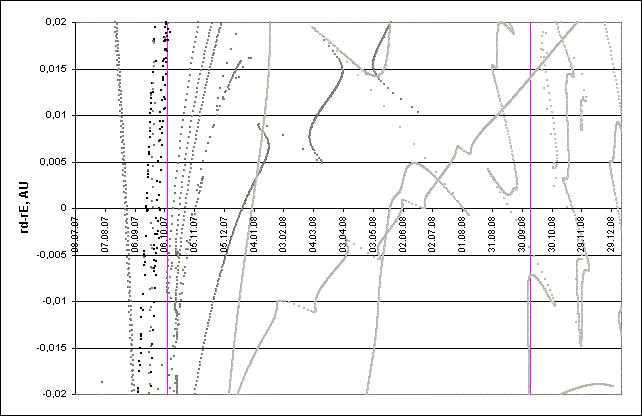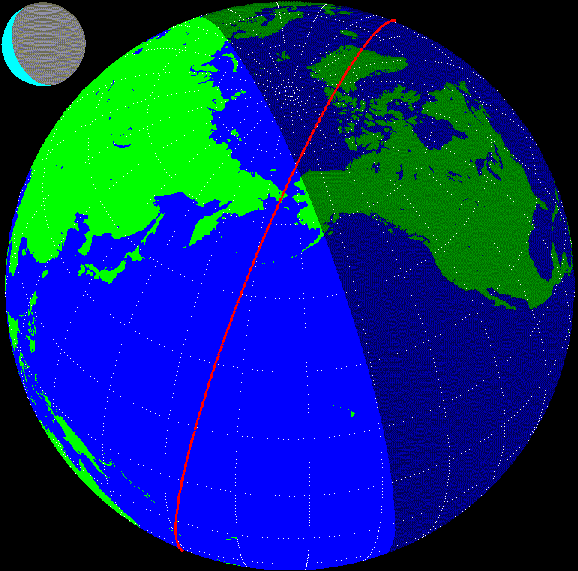Draconids 2007: prediction of activity
to the list of predictions
Introduction
Computation characteristics
We'd like to introduce the results of Draconid meteor stream simulation aimed to the prediction of shower activity in 2007. The simulation was made for the trails of latest 28 revolutions, i.e, from the 1817 trail. The Author used the program by S. Shanov and S. Dubrovsky "Comet's Dust 2.0" to calculate orbital elements of ejected meteor particles. To estimate expected ZHRs for different encounters the model by E. Lyytinen and T. van Flandern given in their paper [4] was used with some Author's alterations made in order to adopt the model for ejection velocity (Vej) instead of da0 (difference in a-semimajor axis) and to convert the model from the Leonid stream (for which it was originally created) to the Draconids. The computation considered only gravitational forces, however, the results are on the whole in good accordance with these of other researchers. The prediction includes all encounters found within interval +/-0.007 a.u. The following parts of trails were computed: the first 15 rev. trails for ejection velocities [-50;100] m/s, 16-28 rev. trails - [-30;50] m/s.
Results
The Fig. 1 below shows the distribution of 21P dust trails in the vicinity of the Earth's orbit within the period of 08.07.2007 - 08.01.2009. The vertical axis shows the minimal distance between trails particles and the Earth's orbit. So far, the Fig. 1 displays the moments of passage of minimal distances to the Earth's orbit for various trails and particles and these distances themselves.
Introduction
Computation characteristics
We'd like to introduce the results of Draconid meteor stream simulation aimed to the prediction of shower activity in 2007. The simulation was made for the trails of latest 28 revolutions, i.e, from the 1817 trail. The Author used the program by S. Shanov and S. Dubrovsky "Comet's Dust 2.0" to calculate orbital elements of ejected meteor particles. To estimate expected ZHRs for different encounters the model by E. Lyytinen and T. van Flandern given in their paper [4] was used with some Author's alterations made in order to adopt the model for ejection velocity (Vej) instead of da0 (difference in a-semimajor axis) and to convert the model from the Leonid stream (for which it was originally created) to the Draconids. The computation considered only gravitational forces, however, the results are on the whole in good accordance with these of other researchers. The prediction includes all encounters found within interval +/-0.007 a.u. The following parts of trails were computed: the first 15 rev. trails for ejection velocities [-50;100] m/s, 16-28 rev. trails - [-30;50] m/s.
Results
The Fig. 1 below shows the distribution of 21P dust trails in the vicinity of the Earth's orbit within the period of 08.07.2007 - 08.01.2009. The vertical axis shows the minimal distance between trails particles and the Earth's orbit. So far, the Fig. 1 displays the moments of passage of minimal distances to the Earth's orbit for various trails and particles and these distances themselves.

Fig. 1. Space-temporal projection of Draconid trails parts onto their minimal distance passages (correspondence between colours of the particles and their ejection velocities can be seen here).
For the year 2007 we can see concentration of trails around the time of minimum distance between the comet and Earth orbit. This part of the Fig. 1 is given on the Fig.2 in more detailed scale. It shows the distribution of 21P dust trails in the vicinity of the Earth's orbit within the period of 08.07.2007 - 08.01.2008. The vertical axis shows the minimal distance between trails particles and the Earth's orbit. So far, the Fig. 2 displays the moments of passage of minimal distances to the Earth's orbit for various trails and particles and these distances themselves. Also, the interesting points of intersection between the Earth's orbit and regular trail parts of the comet 21P are marked with their solar longitudes.

Fig. 2. Space-temporal projection of Draconid trails parts onto their minimal distance passages (correspondence between colours of the particles and their ejection velocities can be seen here).
Encounters between the Earth and vertical trails of 21P are given below in a table .
where trail - year of trail ejection; rD-rE_e - effective distance between the Earth's orbit and trail particles orbits; Vej - velocity of particles ejection on the given trail part (positive values means the particles were ejected against the comet movement, negavive - particles were ejected along the comet movement); fM(fMD) - the characteristic of longitudinal density of the trail, it is derived from the time interval between passages of minimal distance to the Earth's orbit by particles with different ejection velocities; SL - solar longitude corresponding to the maximum; MT - assumed time of maximum.
Assumed activity profile basing on individual maximums is given on the Fig. 3.

We can see, that in 2007 "vertical trails" approach gives three very weak appearances of Draconid activity:
The first with computed ZHR=0.8 should reach maximum at 4:40 UT 7 October, it's connected with 1900 and 1907 trails, average meteor brightness should be very weak, in radiorange more strong activity is possible. Radiant: RA=261.1°, Dec=+47.6°, Vg=18.3 km/s. The Fig. 4 shows the map with regions where this peak would be visible if occured at given time. So far, the best place for observations would be Northern America, especially its western part, as well as Greenland and Iceland.
| encounters with "vertical" trails | |||||
| trail | rD-rE_e | Vej | fM(fMD) | SL | MT |
| - | AU | m/s | - | ° | UT |
| 1900 | 0.00098 | 25.15 | 0.223 | 193.435 | 07.10.2007 04:42 |
| 1907 | 0.00180 | 28.82 | 0.282 | 193.442 | 07.10.2007 04:52 |
| 1887 | -0.00130 | 6.42 | -0.209 | 193.969 | 07.10.2007 17:42 |
| 1894 | -0.00099 | 11.44 | -0.269 | 194.111 | 07.10.2007 21:10 |
| 1845 | -0.00212 | -24.16 | 0.480 | 195.553 | 09.10.2007 08:09 |
| 1852 | -0.00195 | -25.53 | 0.523 | 195.572 | 09.10.2007 08:36 |
Assumed activity profile basing on individual maximums is given on the Fig. 3.

Fig. 3. Assumed Draconid activity profile
We can see, that in 2007 "vertical trails" approach gives three very weak appearances of Draconid activity:
The first with computed ZHR=0.8 should reach maximum at 4:40 UT 7 October, it's connected with 1900 and 1907 trails, average meteor brightness should be very weak, in radiorange more strong activity is possible. Radiant: RA=261.1°, Dec=+47.6°, Vg=18.3 km/s. The Fig. 4 shows the map with regions where this peak would be visible if occured at given time. So far, the best place for observations would be Northern America, especially its western part, as well as Greenland and Iceland.

Fig. 4. The Earth as seen from coming Draconid meteors during the peak at 4:40 UT 7 October. Red line shows the border of hemisphere where the Moon is above horizon (it is shown with in the corner of the Fig. 4 according to its phase).
The second with computed ZHR=2.5 should reach maximum at 21:10 UT 7 October, it's connected with 1887 and 1894 trails, meteor brightness should be on the average level. Radiant: RA=260.8°, Dec=+49.6°, Vg=19.0 km/s. The Fig. 5 shows the map with regions where this peak would be visible if occured at given time. So far, the best place for observations would be Europe, north of Asian part of Russia to the longitude of Taimyr peninsula and the extreme north-west of Africa. The thin lunar crescent won't be an obstacle even where it will be over horizon.

Fig. 5. The Earth as seen from coming Draconid meteors during the peak at 21:10 UT 7 October. Red line shows the border of hemisphere where the Moon is above horizon (it is shown with in the corner of the Fig. 5 according to its phase).
The second with computed ZHR=1.4 should reach maximum at 8:20 UT 9 October, it's connected with 1845 and 1852 trails, meteor brightness should be high, but it should be noted that due to high negative ejection velocities Vej this peak is less reliable, then two previous ones.. Radiant: RA=260.2°, Dec=+52.7°, Vg=20.0 km/s. The Fig. 6 shows the map with regions where this peak would be visible if occured at given time. So far, the best place for observations would be extreme east of Russia (longitudes of Kamchatsk peninsula and farther to the east, as well as north-western part of Northern America.

Fig. 6. The Earth as seen from coming Draconid meteors during the peak at 8:20 UT 9 October. Red line shows the border of hemisphere where the Moon is above horizon (it is shown with in the corner of the Fig. 6 according to its phase).
In 2008, as can be seen on the Fig 1, around the time of Draconin maximum the Earth's orbit is intersected by quite disorganized trail parts consisting of particles with unfavorable ejection velocities. There is no close encounters there, so we do not expect Draconid activity in 2008.
Conclusions
For 2007 "vertical trail" approach shops three very weak Draconid appearances - at 4:40 and 21:10 UT 7 October and 8:20 UT 9 October. Compited ZHR are about 1-2 meteor, and reliability of the peak on 9 October is sufficietly lower than the first two maxima. The Moon can become a little nuisance on 7 October, but by 9 October its influence will come to almost nothing.
References
1. "Comet's dust 2.0" program by S. Shanov and S. Dubrovsky. [Used for orbital computations.]
2. Information from Gary W. Kronk's page http://www.maa.agleia.de
4. Lyytinen E, van Flandern T. "Predicting the strength of Leonid outbursts", 2000, Icarus, P. 158-160.
Conclusions
For 2007 "vertical trail" approach shops three very weak Draconid appearances - at 4:40 and 21:10 UT 7 October and 8:20 UT 9 October. Compited ZHR are about 1-2 meteor, and reliability of the peak on 9 October is sufficietly lower than the first two maxima. The Moon can become a little nuisance on 7 October, but by 9 October its influence will come to almost nothing.
References
1. "Comet's dust 2.0" program by S. Shanov and S. Dubrovsky. [Used for orbital computations.]
2. Information from Gary W. Kronk's page http://www.maa.agleia.de
4. Lyytinen E, van Flandern T. "Predicting the strength of Leonid outbursts", 2000, Icarus, P. 158-160.